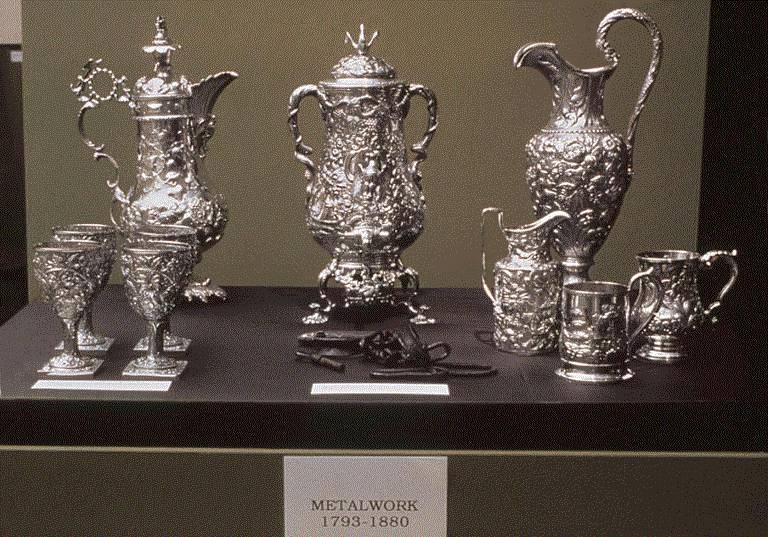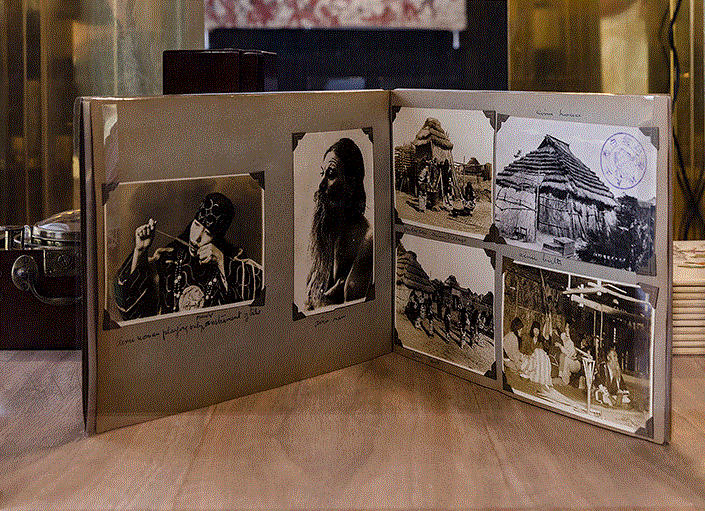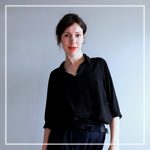You can find the entire cosmos lurking in its least remarkable objects – Wislawa Szymborska, Polish poet
It’s 2013 and I am poring over the Ethnographic Collection of the University of Göttingen with two anthropologists from the research network Dynamics of Religion in Southeast Asia (DORISEA). We are preparing for an exhibition, later to be called Haunted Thresholds: Spirituality in Contemporary Southeast Asia. The collection manager is carefully opening tissue-filled boxes to reveal all sorts of fascinating objects from Indonesia: wooden hand-carved ancestor figures holding the spirits of the deceased, daggers imbued with supernatural powers, a book of spiritually potent medicinal recipes and calendrical drawings and much more.
As we select objects for the exhibition, we debate what information should go alongside them. For the ancestor figures from Nias – How to explain the relationships between the living, the gods and the dead? Should we explain the overarching religious cosmology? What about the cultural context of Nias then and now? In this conversation, we hit a moment of crisis: one anthropologist suddenly felt that we should not show them at all, asking
How can we even exhibit an object if we cannot communicate its full meaning?
This question echoes a curator’s recurring dilemma: how to effectively convey the layers of meaning and significance in an object? The confines of the traditional museological display of a glass vitrine and a short accompanying paragraph can make this feel especially difficult, let alone the awareness that the paragraph might not be read at all, due to a lack of time, energy or desire from visitors.
When exhibiting cultural artefacts, we must inevitably grapple with the difficulty of telling their fluid and multiple realities and histories. This is especially important when presenting artefacts from colonial collections, which form the foundation of many museums. Museums are typically designed to act as informal classrooms, teaching the history of the world, other cultures, medicine, technology and so on. It is therefore generally taken for granted that what is presented in a museum is as ‘truthful’ and ‘objective’ as possible.
In contrast, when visiting an art exhibition, usually we are not primarily looking to learn about history or cultures but instead, we are expecting to encounter ideas that are open to interpretation and up for debate.
As viewers, we know that we are going to need to work a little to try and understand the intention of the artist and the significance of the artwork. Artistic approaches, therefore might contain some clues for how to deal with this issue of how to communicate the ‘full meaning’ of an object by bypassing this goal altogether and instead opening up the possibility of subjectivities and fluidities.
In this article, I share three examples from the contemporary art world that have used artistic strategies to tease out the meanings held within objects. In particular, these strategies also aim to subvert still so common traditional exhibition presentations that arise from the colonial legacies of museums.
Strategy one: contrasting
The position of one object next to another can create new associations and ideas for that object. As a very crude example, if a salt shaker is placed next to a pepper shaker, it suddenly becomes a reminder of the dinner table. If instead the salt shaker is placed next to a pair of maracas, we might re-imagine it as a potential musical instrument. The New York born and based artist Fred Wilson is an expert in these kind of association shifts. Rather than creating a completely new artwork like a sculpture, performance, or film, he is usually more interested in working with and reassembling already existing objects.

Fred Wilson, Metalwork 1793-1880, slave shackles with silver pieces, dimensions variable, in the exhibition, Mining the Museum 1992-3, Maryland Historical Society © Fred Wilson
For his 1992 exhibition Mining the Museum, Wilson was invited to work with the collection of the Maryland Historical Society. Originally founded in 1844, the collection was established to preserve and study the history of the state of Maryland. While it had an extensive collection, the exhibitions shown to the public tended to reflect the perspective of its white male founding board.
For Wilson, “What they put on view says a lot about a museum, but what they don’t put on view says even more” (Fusco, p.148).
Wilson set about ‘mining’ the collection to tell an alternative history to what was usually presented, highlighting the history of African Americans and in particular, slavery in America. One example of how he did this is with the installation Metalwork 1793–1880, which presented a vitrine containing ornate silver pitchers, and teacups, side-by-side with a pair of iron slave shackles. Traditionally within a museum, ‘artefacts of trauma’ (like the shackles) are presented separately to ‘arts and crafts’. Through the juxtaposition of these different artefacts, Wilson created an uncomfortable visual link to two coexisting realities, where the leisure and decadence of one was made possible by the enslavement of the other. Rather than relying on lengthy explanatory text or moralising, Wilson’s seemingly simple placement of the two contrasting objects activates emotional reactions that provoke and shock its viewers.
Strategy two: shifting perspectives
Wilson’s case highlights not only how rearranging objects reveal hidden histories, but also how visual language can draw out emotional and intuitive responses from audiences in ways that text cannot. Brook Andrew is another artist who is especially interested in the multi-layered and alternate realities and meanings of objects, digging into stories related to history, memory, identity and race. However, unlike Wilson, he adds his own interventions to the collections that he works with by creating new methods of display, adding text or obscuring archival imagery with, for example, brightly coloured shapes. Andrew anchors his artistic research in Australian colonial history, while also taking a global perspective to explore how other cultures choose to memorialise past atrocities from the Holocaust to the 1864 Sandy Creek massacre in Colorado, USA.

Brook Andrew, What’s Left Behind (install view), 2018, photo: Silversalt, courtesy Brook Andrew and roslyn oxley9 gallery
In the 2018 Sydney Biennale, Andrew presented the work What’s Left Behind (2018) which consisted of five sculptures created by the artist that also act as vessels or vitrines echoing a stereotypical museum display. The goal of the work was to draw together many voices to bring light to shadowy histories. He invited four additional artists to create displays within his vitrines using objects chosen from the Museum of Applied Arts and Sciences, Sydney. The artists used the Museum’s collection to each explore a range of subjects related to colonial histories. Rushdi Anwar (Kurdistan/Melbourne) focused on the British period of administration (1921 – 1958) in the then Kingdom of Iraq, while Shiraz Bayjoo (Mauritius/London/the Indian Ocean region) explored technologies used to map the colonies such as the marine chronometer. Vered Snear (Israel/USA) dug into British colonisation in Palestine and Australia, and Mayun Kiki (Japan) highlighted the suppression of minority cultures such as the Ainu people of Japan. Finally, Andrew interrogated the exoticisation of the East and its enduring legacy.

Brook Andrew, What’s Left Behind (install view), 2018, photo: Silversalt, courtesy Brook Andrew and roslyn oxley9 gallery
One notable aspect of the vitrines was that the artists not only created additional artworks to enrich the objects from the collection, but they also included additional historical items sourced either from their own collections or purchased especially for the exhibition. On one hand, in a cynical frame of mind, this makes apparent that the Museum of Applied Arts and Science was missing significant artefacts related to colonial histories. On the other hand, I think we can be much more generous and see how this points to the infinite nature of material culture and the intricately tangled web of significances and meanings woven between objects and histories. How can a museum contain every object related to every history in the world and tell every story? This case highlights the difficulty of dealing with material culture: what objects to choose and which stories to tell?
By building on the collection and adding additional interventions of artistic creations, self-made displays and historical artefacts, the artists showed how one single collection can open up many personal perspectives to point toward many different (and often untold) histories, cultural experiences and interpretations.
Strategy three: revealing
Returning to the scene of my initial curator’s dilemma in the ethnographic collection of the University of Göttingen, one of the discoveries that we made there was that each object in the collection was accompanied by a beautiful handwritten index card with a pencil drawing of the object. The cards stated the location of origin, the collection that it came from, the year it arrived in the Göttingen collection and a basic description of the object’s function, size and dimensions. I frequently (and it turns out naively) asked the collection manager when an object would have been in original use, but the only certain answer he could give me was the date that it arrived in Göttingen.
I was quite struck by the seeming double life of these objects.
Initially ‘born’ in Indonesia they held a distinct cultural position, and played significant roles in rituals, ceremonies, performances and so on. It wasn’t until they arrived in Göttingen, marked with a new year of origin, that they were ‘born again’ as ethnographic objects. With this new existence came a new function: the perusal and education of the German public. Of course I’m not the first to have this thought, Alain Resnais, Ghislain Cloquet and Chris Marker’s video essay Les Statues Meurent Aussi (Statues Also Die) from 1953 portrays the ‘death’ of Sub-Saharan African masks and sculptures as they enter colonial archives, losing their original function to be transformed into a museum artefact.

Index card courtesy of the Ethnographic Collection of the Ethnographic Collection Georg-August-University Göttingen
“What if we exhibit the index cards?” suggested one of the DORISEA anthropologists, Karin Klenke. This seemingly simple suggestion became a way for us to point toward the double life of the objects and the unique context that they now found themselves in. In the exhibition, we displayed the cards separately to the ethnographic objects, as ‘artefacts’ unto themselves. In doing so, we wanted to reveal for the audience how these objects are classified ‘behind-the-scenes’ and to tell the story not only of how the object came into existence but how it then came to be on display in front of a viewer for their consumption and education. We also hoped that viewers might gain some awareness that their understanding of the object is shaped through a very specific ‘Göttingen lens’ and that the objects have travelled on a somewhat messy and contested journey that will continue in future.
These three case studies show how creative approaches to exhibiting cultural artefacts can help to overcome the traditional museum dilemma of attempting to convey their ‘full meaning’ and instead open up their multiple realities.
The juxtaposition of historical objects can create new conceptual links to uncomfortable stories, while inviting different practitioners to work on the same single collection can emphasise the myriad interpretations and narratives contained within objects. Finally, by acknowledging how objects arrived in collections and highlighting their current social function and location, their display in an exhibition can act as a mirror to reflect back our own role within the shifting realities of these objects.
Reference
Coco Fusco, “The Other History of Intercultural Performance”, TDR: Journal of Performance Studies 38, no. 1 (Spring 1994).





